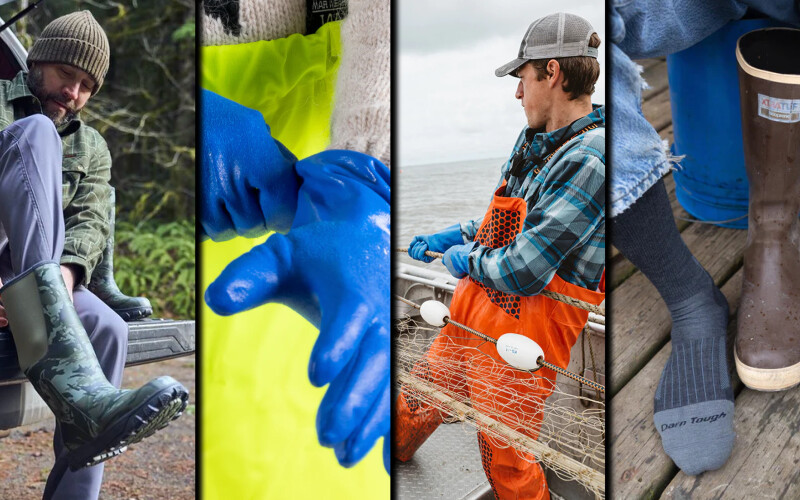As the Alaska summer fisheries kick into gear, it is time for seasonal fishermen to think about packing their duffle bags. What goes inside is a key part to a comfortable and profitable season. Below is a guide of what to pack to wear on deck, from head to toe.

Raingear
As a baseline, we always recommend one of the tried and true heavy-duty jacket and bib combinations. The cornerstones here are the good old Grundens Herkules 16 raingear or any of the heavier-weight Guy Cotten alternatives, like the X-Trapper line. Both of these are thick and durable, with a relaxed, old-school fit that allows for layering underneath.
There’s nothing fancy about the Herkules—it’s just PVC-coated polyester—but there are reasons it has been ubiquitous in the industry since Grundéns rolled it out in 1954.: It keeps you dry in almost any condition and will hold up for multiple seasons. Having said that, both the Herkules and the X-Trapper lines are a bit cumbersome, with a baggy fit and stiff, clunky material that can be suffocating under some conditions, especially in Alaska’s active summer fisheries. They are also slow to dry and quick to mold, meaning most deckhands now have a small quiver of gear they can rotate through, with a handful of jackets and bibs for different weather conditions and times of the day and night.
The past decade or so has seen a flood of new products made of tons of different materials that have made raingear lighter, more breathable, and easier to move in. Grundéns has been a leader here too, with their Neptune line among the most popular. The Neptune jacket and bibs feature a stretchy medium-weight polyester fabric coated in polyurethane that is easier to move in than the Herkules. The only gripe about the Neptune has been that it nicks easily and leaves you wet by mid-season, a complaint Grundéns has attempted to counter with their new, beefed-up Neptune Pro Line.
Without sacrificing wearability or mobility, this new line adds abrasion-resistant overlay panels to wear areas on both the jacket and bibs and should give the Neptune a longer life on deck. The bibs also feature built-in, removable knee pads.
Reliable alternatives in a similar vein as the Neptune include the Helly Hansen Storm Rain jacket and bibs, which are very well made. Many fishermen now want alternatives that are not “rubber,” and newcomer Vallation has a couple good options.
Vallation was founded recently by Cory Jackson, whose dad Dave and uncle Mat ran Grundéns’ operations here in the US for nearly three decades. His Dark Rain jacket and bibs are made of heavy-duty nylon with a Teflon shield, and both have a very solid feel to them for nylon. We haven’t had the chance to try them on deck but out of the box, they inspire confidence and are very wearable.
We also talked to Pacific Northwest fisherman Christian Tom, who has been testing gear for Vallation for the past year. Tom called the Dark Rain gear “bulletproof” after putting it through the wringer this winter. He wore it in nasty Northwest winter weather in several different fisheries—crab, shrimp, salmon, even shellfish—and with different gear types, including pots, seining, and set netting, and said the Dark Rain has no nicks and still keeps him dry.
Tom also had good things to say about Vallation’s Ocean Watch jacket, a coat inspired by the discontinued Red Ledge coat that many commercial fishermen used. The coat has nice features like pit zips and velcro cuffs, and Jackson said the nylon on his Ocean Watch is very high quality. The Ocean Watch feels more papery than the Dark Rain, but Tom said it has surprised him, even holding up to the snags and rigors of crabbing with pots. Jackson is only selling Vallation through marine supply stores.
If you can, always try raingear on, as certain companies tend to make gear that fits a certain body type, and sizing can be a bit erratic, even with an established company like Grundéns.

Boots
The right boots are the foundation to a good fishing season, and much like coats and bibs, fishermen were once faced with an easy decision. You went out and picked up some XTRATUF Legacy boots (or even better, you just pulled last season’s Legacy boots out of the closet and went to work). But XTRATUF opened the door to competition over a decade ago when they moved manufacturing to China, and their boots were no longer so extra tough, and competitors rushed in to create what is now a diverse and evolving market.
Many fishermen will stick with the familiarity and fit of the old XTRATUF Legacy boots, and if they work for you, there is really no reason to change. However, we’re still under the opinion that the Grundéns DeckBoss boots are higher quality and more comfortable.
The injection-molded DeckBoss boots will not delaminate, and the outsole is built out like an athletic shoe, providing more comfort and support. This season, Grundéns is adding to their line of 15-inch deck boots with the new Deviation Tall Boot. Originally a very popular ankle boot, the 6-inch Deviation Boot has a heavily lugged sole and feels thick and cushy underfoot. These attributes have been transferred to the Deviation Tall Boot, along with a wide neoprene cuff around the calf to facilitate getting them off and on.
These boots will not be everyone, especially if you like the low profile of XTRATUF’s Legacy boots. They will ride higher on deck and will need to be taken off before doffing and donning bibs, but for some deckhands and skippers, they will be just the thing. They would make an excellent boot for setnetters or other fishermen who are jumping from deck to muddy shores.

Gloves
Showa Atlas is still the top dog here, and they have kept a grip on the glove market by maintaining consistent quality in recent years.
The orange Showa Atlas 620s are like the Herkules of gloves, dependable stalwarts that will get you through the season. With double-dipped PVC, a 12-inch cuff, and a track record of reliability, every deckhand should have a package, or two stowed away in the galley.
For a warmer glove, we’ve raved before about the Showa Atlas 490 gloves, and we’ll do it again. The 490s have triple-dipped PVC over an acrylic fleece liner and provide a nice combination of warmth and mobility. And while we still like the 490s, new competitors are nipping at Showa Atlas’ heels.
Icelandic company Marwear may be making the best gloves out there, especially for colder weather. In particular, the Blizzard Nitrile Gloves are fantastic. They are fleece-lined and warm but allow for enough digital dexterity to pick fish, bait hooks, and sort through net, and stay pliable through extremely cold temperatures, making them great for the freezer.
Marwear’s Polar Flex Nitrile gloves are another insulated option that are similar to the 490s but even more flexible, with a specially treated nitrile coating that doesn’t freeze until -22 Fahrenheit and a cozy polyester fleece lining. We also wouldn’t hesitate to count on Marwear’s unlined Nitrile NBR Supported Gloves as your everyday gloves for summer fisheries, from gillnetting to longlining and everything in between.
Also, another note: Be sure to pack plenty of Neosporin and bandages and be diligent about keeping cuts and nicks on your hands doctored. The smallest wound can fester under gloves, get infected, and prompt unpopular downtime, if not ruin a season altogether.

Layering
Before one of my first jobs in Bristol Bay, a former skipper suggested that I pack my duffle bag with the same layers I would use for skiing. As a skier, I knew exactly what that meant, and it turned out to be the perfect way to go about it. Not everyone is a skier, like a guy I worked with one summer who wore skinny jeans under his bibs, but the main point here, and we’ve been beating this drum for a while, is to avoid cotton as much as possible.
There is a wide variety of options in wool and synthetics, or a blend of the two, that runs the gamut in quality and price, with basically all of them outperforming the traditional cotton hoodie. If you’re one of these fishermen who has hit recent big years in Bristol Bay, for example, and are looking for maximum performance and comfort, head over to the Smartwool website and spend a little chunk of that hard-earned crew share on their Classic Thermal line.
If wool is not appealing (it can be a pain to care for—not the best on a boat) and that money is burning a hole, any of Patagonia’s Capilene layers will do the trick for multiple seasons.
Helly Hansen is a reliable alternative as well. Their Merino blend base layers have a synthetic LIFA lining to pull moisture away from the skin and a warm outer layer of wool. If you are on a budget, check out discount websites like Sierra Designs, or go to any of your local outdoor stores like Cabela’s, Dick’s, or REI and pick up their basic thermal layers. Any synthetic fabric like polypropylene, nylon, or polyester should do the trick, just as long as it is not cotton.
This same logic extends to socks. If you have money to spend, get the Smartwool or Darn Tough (if you want to be especially on brand, get the Salmon Sisters collaboration with Darn Tough), and if you are on a budget, pick up a couple of packages of wool socks from an outdoor store.
It is also worthwhile to look into a heavier layer that can be worn under a raincoat or on its own for lighter duty on deck. Grundéns Bering Sea Hoodie fits this bill and will likely be the garment you wear most during the season. It is made of extra thick fleece and has some polyester overlays on the shoulders for more water protection, making for a very warm, comforting layer. The Buklhead coats from Grundéns are also recommended, with a rugged outer layer of DWR-treated nylon over a grid fleece backer.







